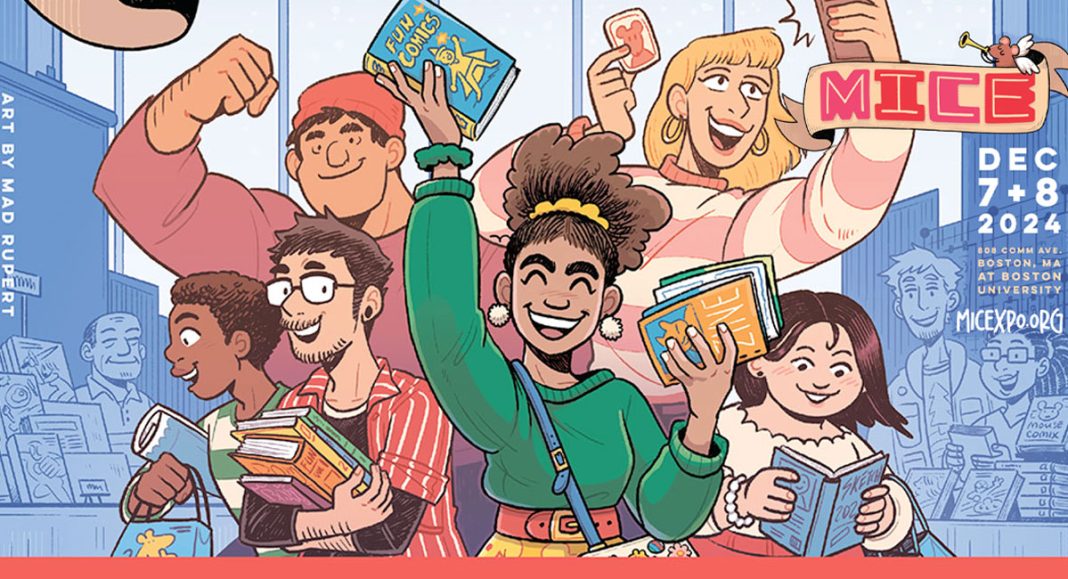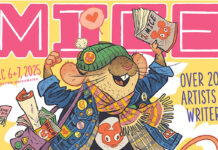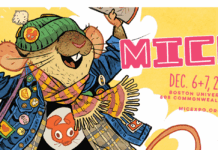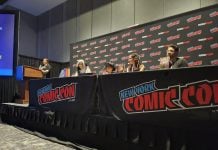Sunday afternoon, the second day of MICE, and I’m headed to a panel. The Massachusetts Independent Comics Expo is celebrating their fifteenth anniversary this year, going from a (locked) room at the end of Newbury Street to Boston University‘s historic Fuller Building on Comm Ave, a former luxury car showroom on the Charles River. It’s a comic convention unlike most. Small print runs, tremendous cultural capital.
To get to the panels, first one must pass through the Curiosity Portal. Before the raffle table and the original comic art displays, after you’ve been given one of those little museum attendant clings (MICE is sponsored by BCAF, the Boston Comics Art Foundation, and admission is free) by a friendly volunteer. I encountered a horde of bipedal rats, though in sticky note form. There were writing prompts on the Portal walls, relating to the MICE experience, and blank notepads shaped like word balloons. I noticed a lot of notes from people grateful for the show’s masking requirement. Through some doors, up some stairs, I found one of the last seats, though they ended up bringing in more chairs.
The panel: “Hue and Saturation: Uses of Color in Comics.” Moderated by longtime MICE advocate Zach Clemente of Bulgilhan Press. The panelists: 1000 Dead Draculas (which is actually one person, Natasha Tara Petrović). Ethan M Aldridge. Matt Emmons. Henry Uhrik, talking about his collaborations with Kruttika Susaria. A lively audience, full of affirmative grunts, audible gasps and Eurekas, one room-wide positive noise in response to the mention of Samurai Jack as a coloring and aesthetic influence so loud that the panel had to pause, laugh, and second that emotion.
Half about technique and half about inspiration, the resulting conversation was often ostensibly about practice, but driven by unique and often contradictory perspectives. Time management came up in many forms. Emmons and Draculas both moved away from using a finished “inked” line to define their art because of the time it took, working in pencil and color respectively. Aldrige is all line, multiple colored inks via dip pen for contours and then a watercolor wash. The color inks extending into the character of the paint palette is something pinched from the practice of classic fairytale illustrators. And they are fast drying inks, so by the time the paints have been put together, there’s no waiting on the line art not being set. Time management. All these artists who strip away the things about making comics that don’t add to their art also have established powerful, original styles uniquely their own.
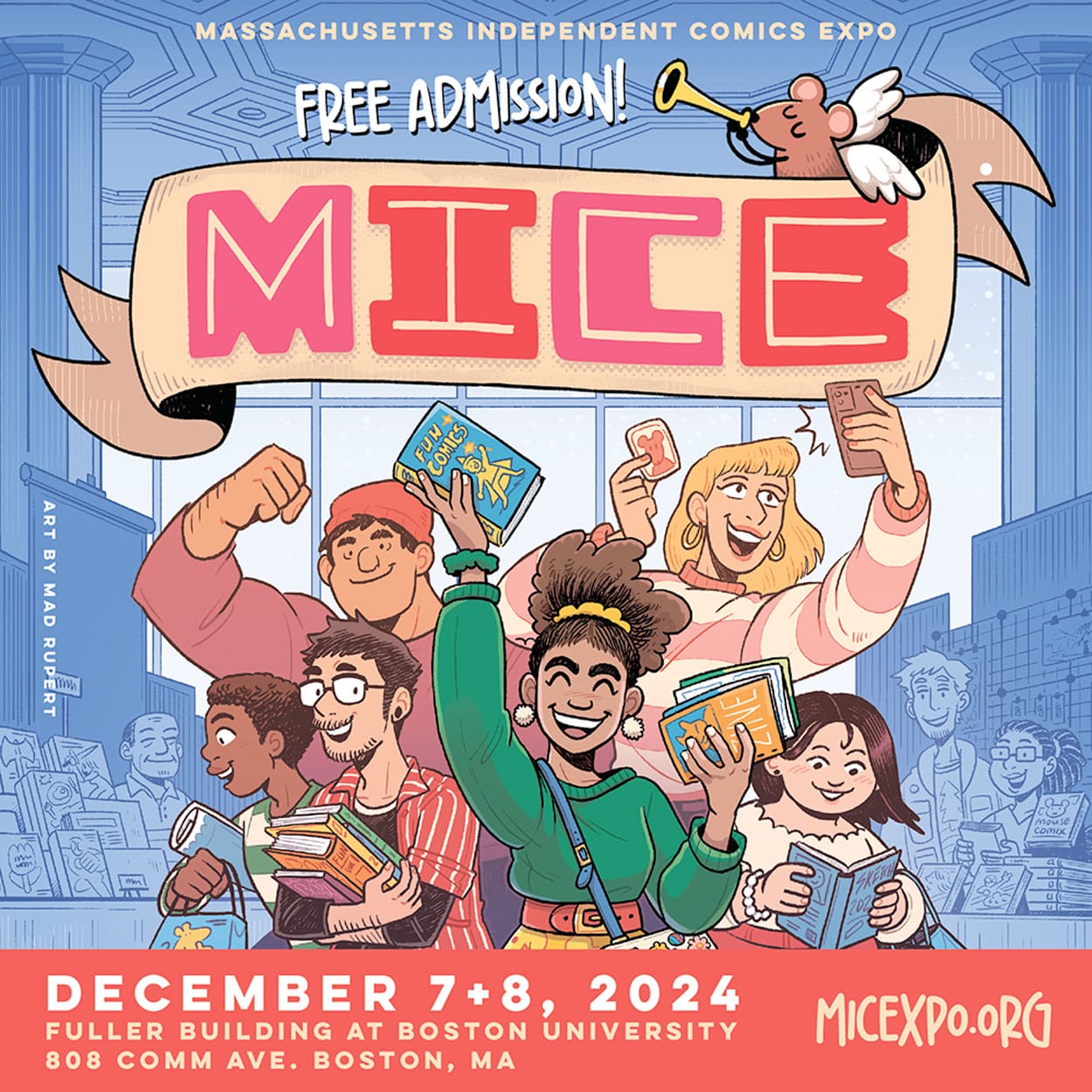
The panel stressed that the real connection between time management enabling professional success and people starting out facing the hurdles in learning a new craft is simplicity being a key to scale. Needing to eliminate extraneous steps comes from the demand of mass production. Making a comic is something anyone can do— it’s making comics that’s the headache. Another thing that all the artists on the panel had in common was they let go of the idea of a finalized piece resulting from the pre-production process. Despite the importance of time management, the work itself yields clues that one pursues. Technical limitations inspire dynamic creative decisions.
I asked Emmons after the panel if the digital art was what he pictured as finished, or if it had to be more saturated, so that it would come out the way he wanted it to when it came out of the RISO printer, making that the “finished” version of the art. His answer cut both ways, intention and discovery. Part of the printing process meant adjusting the settings on the machine so that what’s on the page are the colors as he intended them to be. But the other part is allowing the reality of the production process to adjust his perception of what looks “best,” and arriving at a satisfyingly “finished” work rather than being kept from realizing an exact vision.
This was in the Boston Room exhibition hall. First I hit Lucky Pocket Press. They’re from as close to CT as its possible to get in NY. Is MICE the show to do in the Northeast now, as well as New England? I was too busy gushing about their stuff to ask Sara Hagstrom and Steph Bulante. Lucky Pocket is a risograph micro publisher. And RISO is a prominent DIY cultural presence in the small press these days. More and more art collectives coming together so that they won’t have to wait for someone else to put out their work. PrintNinja, an offset printing service, is a sponsor of MICE and has a table on the other side of the room. MICE is for people who want to good comics out there in the world.

So one of my favorite books this year was from a Lucky Pocket KS campaign. A phonebook-sized anthology, printed in pink and blue, a tribute to circa 2000s Shojo Beat and Shonen Jump collections. Knapsack Vol. 1: Cassette (yeah it’s also music themed) was funded in March and shipped in August. Thoughtfully put together, down to the color of the ink on the page (same for Basket). Not just attention to detail, a love for little things.
I mean, look at their booth. An assortment of the comics and zines they’ve produced- including a stack of Knapsacks and a preview printing of Basket folks can flip through. Neat RISO KS QR code note on the table. Pins. Stickers. And prints! The old trend was prints hung behind the artist, or a portfolio laid out on the table to flip through. The new way reminds me a bit of the science fair, the table becomes a little gallery storefront, with a teller window in the center. Hi! Could I have a Rec Room and a printer sticker? Thanks! Crowned with a little Lucky Pocket pennant, it’s very sweet, very aesthetically appealing, and it’s practical: the wave of illustrators who are personally involved in the printing process has increased the amount of smaller prints (and little, textural details). Bringing them closer to those browsing is to the benefit of the RISO medium, and I’m not just saying that as someone who is super nearsighted.
MICE a compelling contradiction in comics convention expectations. If MICE is an indie con for weirdos (complimentary) and the OCs, a more mainstream one would feature celebrity guests and lunchbox characters- and a sacred section of the floor called Artist’s Alley, where the folks who actually make comics sell their stuff. Over time, the amount of (and demand for) “stuff” has skyrocketed, and the big name exhibitors have shifted focus from comics to entertainment involving comics IP. Where, they ask, are the comics? Well, they’re inarguably at MICE. Somehow shows like Boston’s have found a way for comics and prints and stickers and such to coexist, and Lucky Pocket is an awesome example of that.
Glacier Bay is on one side of the Boston Room, across the row from LPP. An indie manga publisher. Aesthetically they fit in here perfectly, though their creators live on the other side of the planet. Gourmet micro press curators are the Criterion Collection of comics: they care about the wildly independent story being told within, and they work their asses off to make the medium of storytelling just as sophisticated. The books themselves, beautifully unique. Bulgilhan Press is around the corner. Their graphic novel, Huahua Zhu’s The King’s Warrior– like Lord Dunsany’s Link’s Awakening– is another on my shortlist for books of the year. Not only can you find comics at MICE, they are the best comics one can possibly find.
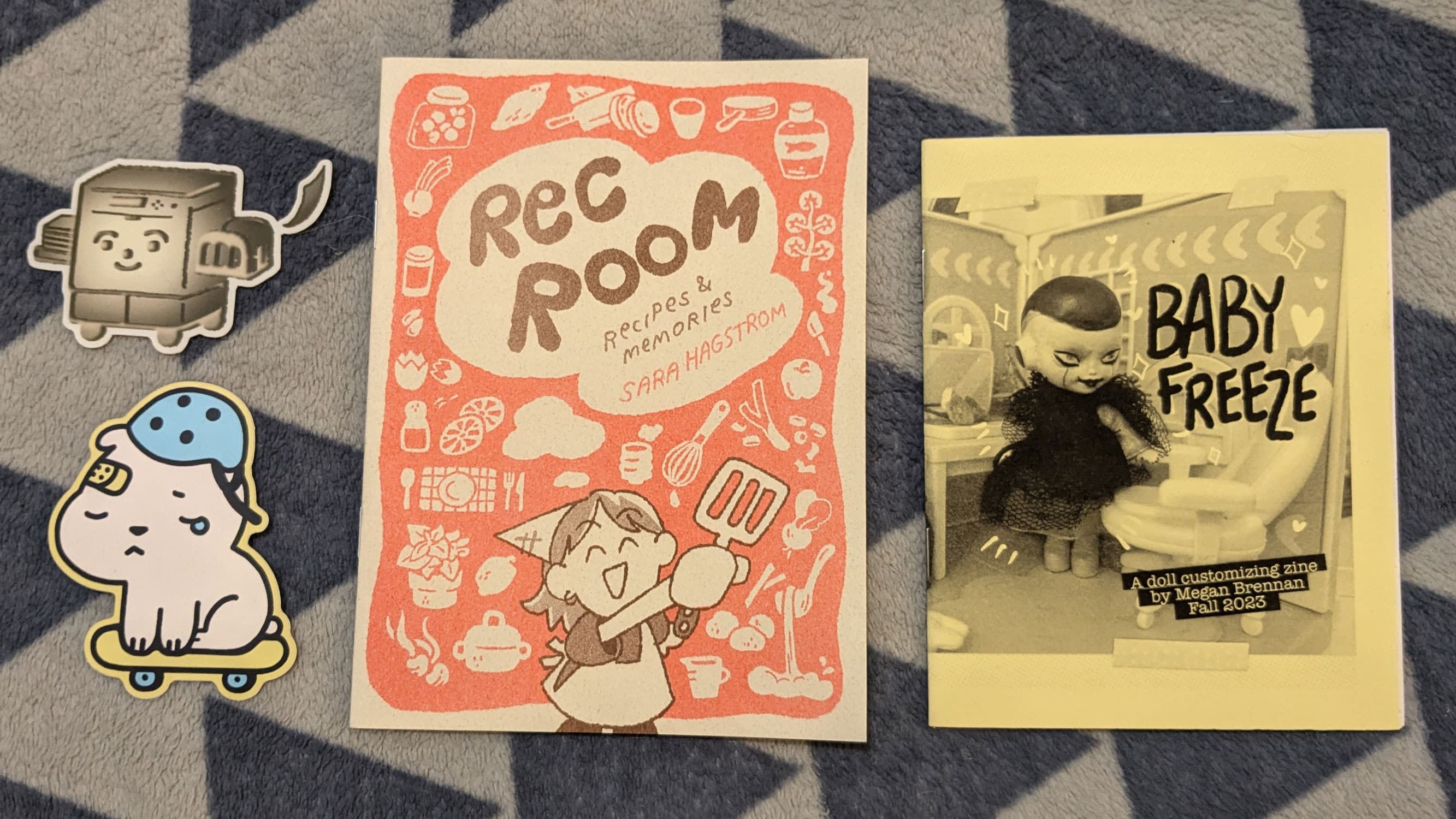
Against Albert Kahn‘s Detroit-style showroom windows, the two sides meet to form a row of the featured exhibitors. This year’s keynote speaker Deena Mohammed, alt-comix luminary Denis Kitchen, all-around legend Keith Knight. Vermont’s current Cartoonist Laureate Tillie Walden, a CCS graduate. Tony Davis, the owner of Million Year Picnic, is in the center, putting books in people’s hands (for me it was Godzilla: Monster Island Summer Camp). MICE’s fifteenth is great way to close out 2024 for MYP, their fiftieth year in business- they are New England’s oldest comic shop, as well as one of the few Black-owned comic shops in the US.
The Brookline Room is on the other side of the hallway. Every MICE location I’ve attended has used whatever space was at hand to add more exhibitors. They lined the halls in Cambridge; here in Boston they opened a second exhibit hall. Bumper to bumper, just like the Boston Room, with the same mix of comics, books, prints, and creative solutions for tabletop display setups. I saw new issues of a series I’d picked up in 2022 (Spaghetti Punch, it’s fantastic)! Maybe it was all the doodles on the wall that’s also a whiteboard, or maybe it was watching someone crawling out from under their table into the aisle instead of going all the way around, but in here I felt a little like the old school, VFW-style spirit of MICE remained untouched by time. Eternally abundant.


